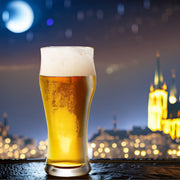Pilsner Extract Beer Recipe Kits
How would you describe Pilsners? Ideas like clean, crisp, and hard to beat come to mind and for good reason — Pilsners are the gold standard for refreshing beer. Our Pilsner extract recipe kits make it easy to brew your own at home. Pilsners are a class of lagers, which traditionally involve cool fermentation. However, if you don’t have to ability to ferment cool, no problem! With modern yeast, lager fermentations are easily adapted to room temperature conditions, so no cold fermentation gear required. You’ll get smooth malt flavor, floral hop character, and that classic finish that made Pilsners the most popular beer style in the world. Go traditional with a Bohemian-style lager or try a pre-Prohibition twist. Either way, you’re in for a clean pour, a golden lager and a clear win.

-
Velvet Revolution Bohemian Pilsner Extract Beer Recipe Kit from $54.99

-
Get Wrecked, Noob! Imperial Pilsner Ale Extract Beer Recipe Kit from $56.99

-
Space Cowgirl Retro-Futuristic Pilsner Extract Beer Recipe Kit from $42.99

-
Puddle Jumper Pre-Prohibition Pilsner Extract Beer Recipe Kit from $42.99

-
Sapporo Clone – Japanese Rice Lager Extract Beer Recipe Kit from $44.99

-
Stroh's American Lager Clone Extract Beer Recipe Kit from $39.99

Frequently Asked Questions: Pilsner Extract Beer Recipe Kits
Where did Pilsners come from?
Pilsners originated in the city of Plzeň (Pilsen), in what is now the Czech Republic. The first Pilsner was brewed there in 1842, giving rise to the world’s most popular beer style. The name “Pilsner” simply means “from Pilsen.”
What makes a Pilsner different from other lagers?
Pilsners are pale lagers known for their crisp finish, light body, and firm hop bitterness. Compared to standard American lagers, Pilsners have more flavor, more aroma, and a cleaner profile that highlights quality ingredients.
Do I need to ferment Pilsners at cold temperatures?
Traditionally, yes — authentic Pilsners are fermented cold with lager yeast. But if you don’t have temperature control, you can still brew a great Pilsner using a clean, lager-like yeast such as Lutra, which works beautifully at room temperature.
Are Pilsners beginner-friendly to brew?
Absolutely! While they’re crisp and delicate in flavor, extract Pilsner kits are very approachable. You don’t need a mash tun or special gear — just good ingredients, clean fermentation, and a little patience.
What kind of hops are used in Pilsners?
Classic Pilsners use noble hop varieties like Saaz, Hallertau, or Tettnang. These hops give the beer a floral, slightly spicy aroma with balanced bitterness and a clean finish.
How long does it take to brew and enjoy a Pilsner?
Expect about 2–3 hours on brew day, then 1–2 weeks of fermentation, followed by 4–6 weeks of conditioning. Pilsners benefit from longer lagering time, but they’re worth the wait.
For my first Pilsner, where should I begin?
If you're new to brewing Pilsners, it helps to start with a kit that’s beginner-friendly but still delivers on flavor. Extract kits take out the guesswork and give you a great head start toward brewing crisp, clean beer.
Start with our Velvet Revolution Bohemian Pilsner for a traditional Czech-style experience, or try Puddle Jumper Pre-Prohibition Pilsner for a smooth, old-school American twist.
What food pairs well with Pilsners?
Pilsners go great with grilled sausages, fried chicken, seafood, or anything salty and crisp. Their clean finish and subtle bitterness make them one of the most food-friendly beers out there.
Can I use a different yeast for Pilsners?
Yes — if you can’t ferment at cold temperatures, there are still great options. Some modern yeast strains mimic the clean character of traditional lager yeast while working well at room temperature.






